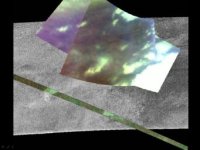Massive Mountains on Titan
13 December 2006
Observations made during the recent flyby of Titan, on 25 October 2006, by the Cassini spacecraft, have revealed a massive mountain range on Saturn's largest moon. The mountains stand 1.5 km tall and are the highest ever seen on Titan.
 |
|
Credit: NASA/JPL/University of Arizona |
The composite VIMS image on the right shows the large continuous mountain range, which runs just south of Titan's equator. The range is about 150 km long and 30 km wide. The peaks are topped with bright white material, which is possibly methane snow. The mountains are thought to have been formed by material welling up from below after separation of tectonic plates.
By combining the infrared data from VIMS with radio observations from the Cassini radar instrument, more details on Titans geological features can be discerned. The infrared images contain information on the terrain composition, and also shadows can be used for determining heights of features. The radar observations show the features' shape and structure.
 |
|
Credit: NASA/JPL/University of Arizona |
The origin of clouds on Titan's southern mid latitudes is as yet not fully understood. At the bottom of the rightmost image, a bright band of clouds is seen running over terrain that is riddled with mountain ranges. This image was also obtained by the VIMS instrument during the recent high-resolution pass and encompasses a slightly bigger area around the mountain range than in the above close-up.
The clouds in this image are probably produced when gaseous methane in the atmosphere is driven over the mountains by winds, causing it to cool and condense into methane fog.
 |
|
Credit: NASA/JPL/University of Arizona |
Cryovolcanism
The combined radar and infrared view has provided evidence for the existence of a cryovolcano on Titan. Radio images, obtained during an earlier flyby in February 2005, already showed the presence of a circular feature with a fan-shaped feature extending from it.
High-resolution observations by VIMS from the 25 October 2006 flyby, made in a strip crossing the fan-shaped feature, strengthen the evidence that material is deposited after erupting from the small circular crater.
